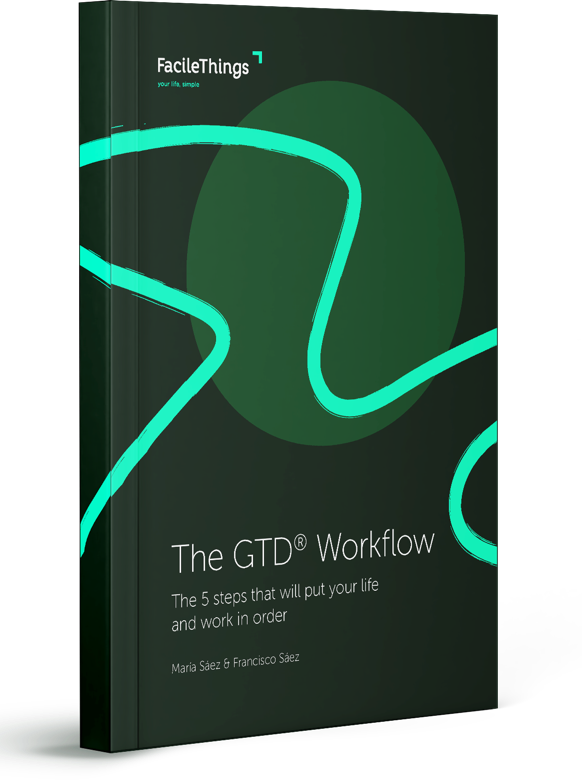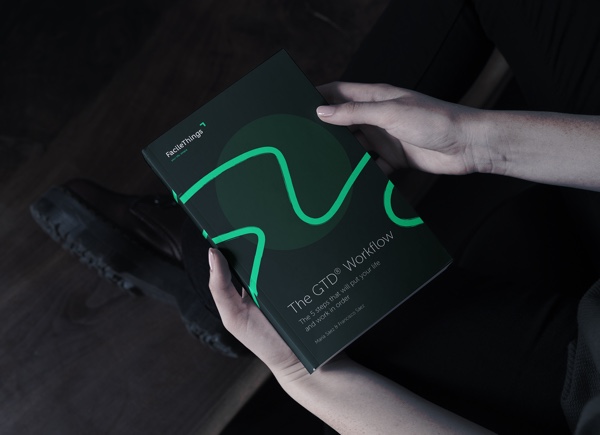Getting Things Done - GTD
The Most Important Habit for Productivity: Capture Everything That Grabs Your Attention
AUTHOR: María Sáez
You’re in a meeting when you suddenly remember that you need to call the dentist. While driving home, you come up with a brilliant idea to improve that project you’ve been stuck with for weeks. During dinner, your partner mentions that you need to renew your car insurance before the end of the month.
What happens to all these things? In most cases, they linger in your mind, fighting for your attention and creating a persistent feeling that you are “forgetting something important.” You will remember some of them at the right time, but others you won’t. And in the meantime, they’re all consuming valuable mental resources that you could be spending on thinking, creating, or simply enjoying the present moment.
The solution to this problem is so simple and improves life in so many ways that we should do everything in our power to adopt it. Capturing everything that catches your attention is a key productive habit.
Why capturing everything is essential
David Allen, creator of the GTD methodology, Getting Things Done, expressed it memorably:
“Your mind is for having ideas, not for holding them”
And he was right. Our brain is an extraordinary tool for thinking, analyzing, creating, and solving problems. But it’s a terrible storage and reminder system.
There’s a psychological phenomenon known as the Zeigarnik effect that explains why unfinished tasks and unmanaged commitments have such a powerful impact on our minds. As psychologist Bluma Zeigarnik demonstrated, our brains keep pending tasks active, constantly reminding us of them until we complete them or, at least, until we establish a clear plan to deal with them.
This means that every time you decide, “I’ll remember this,” you’re adding another burden to your mind. And it’s not just one thing: it’s dozens, maybe hundreds of small commitments, ideas, and reminders that your brain tries to keep active simultaneously. The outcome is a persistent feeling of overwhelm, difficulty concentrating, and the uncomfortable certainty that you’re forgetting something important.
This is where the power of capturing comes in: when you capture something in a reliable external system, your mind can let it go. The Zeigarnik effect is deactivated because you have closed the loop: you no longer need to remember it because it’s in a safe place where you know you’ll see it again.
But the key is that your system will only be reliable if you capture everything. If you only capture some things, your mind won’t be able to relax because it knows it can’t completely trust the system. It will keep trying to remind you of everything, just in case.
What does “capture everything” mean?
When we talk about capturing, we don’t just mean obvious tasks like “buy milk” or “send that report.” Capturing encompasses anything that, when it crosses your mind, tells you “this is important” or “I should do something with this.”
- Tasks and commitments: Things you have to do, from the most mundane to the most strategic.
- Ideas: That concept for a new project, the solution to a problem, an improvement you could implement.
- Relevant information: An article you want to read, a piece of information you’ll need later, a useful reference.
- Potential projects: That renovation you’d like to do, the course you want to take, the trip you want to plan.
- Concerns and issues to resolve: Situations that bother you and that you may need to think about or act on.
It’s crucial to understand that capturing is not organizing. When you capture, you simply collect information as it comes in, without judging it, without categorizing it, without deciding what to do with it. That’s a fundamental separation that makes the habit of capturing sustainable: it’s fast, it doesn’t require deep thought, and therefore you can do it anytime, anywhere.
The benefits of a complete inventory
When you develop the habit of systematically capturing everything, you build what we might call a “complete inventory” of your reality: all the things you have on your plate, all the commitments you’ve made, all the ideas you want to explore, all the concerns you need to address.
This complete inventory is the foundation upon which a robust organizational system is built, and its benefits are profound:
- Clear and focused mind: When your mind knows that everything is captured, it can stop trying to constantly remind you. This frees up a surprising amount of mental resources. People who develop this habit describe a feeling of “mental lightness” that they had not experienced before.
- Ability to prioritize with real perspective: You can’t prioritize properly if you don’t know everything you have to do. A complete inventory allows you to see the whole picture and make informed decisions about where to invest your time and energy. Without it, you’re constantly reacting to what you remember at any given moment (which is never “everything”), not to what really matters.
- Reduced stress and anxiety: Much of the stress we experience does not come from having too much to do, but from uncertainty about what we need to do. A complete inventory eliminates that uncertainty. You may still have a lot to do, but at least you know it, you have it under control, and you can manage it consciously.
- Solid foundation for planning: Whether you are planning your day, your week, or your long-term goals, you need to start with a complete overview of your commitments and possibilities. An incomplete inventory leads to unrealistic plans that you cannot fulfill (because other things come up that you hadn’t considered), which erodes your confidence in your own organizational abilities.
How to develop the capture habit
Developing the habit of capturing everything requires two fundamental things: always accessible tools and the right mindset.
The best capture system is the one you have on hand when the thought arises. It could be a notebook and pen on your nightstand, the notes app on your phone, a voice recorder, the inbox of your task management app, or even sending yourself an email. The important thing is not the specific tool, but to always have some way of capturing ideas available. Many people use different tools depending on the context: paper at home, their phone when they’re out, their computer when they’re at work. They all fuel the same system.
One of the most common mistakes is trying to filter while capturing. A thought pops into your head and you think, “This is silly, it’s not worth writing down” or “I’m sure I’ll remember this.” But that’s the problem: you’re judging before you capture, which adds friction to the process. The golden rule is: if something caught your attention enough to notice it, it deserves to be captured. You can decide later whether it really requires action or not. Processing the things you capture is not part of capturing.
Although ideally you capture in the moment, there are certain times of day that are especially fertile for capturing:
- Upon waking up, when your mind is fresh and ideas or reminders may arise.
- At the end of the workday, mentally reviewing what remains pending.
- After meetings, important conversations, or intense work sessions.
- During commutes, when your mind wanders and random thoughts appear.
At first, capturing requires awareness and effort. You have to actively remind yourself to do it. But with practice, it becomes an automatic reflex. A thought arises, and almost without thinking, you capture it. This is the level of mastery you should aspire to: capturing as a habit so ingrained that you don’t even have to think about it.
From capture to your organizational system
Many people feel overwhelmed when they find their inbox full of captured items. Don’t see it as a problem; it’s just the opposite. It’s your raw material, the honest inventory from which you can build an organizational system that really works.
When you process that inbox (a different practice from capturing, which should be done at specific times dedicated to it), you transform each “thing” into something specific:
- Is it something you can do in less than two minutes? Do it now.
- Is it something that takes more time? Add it to your next actions list.
- Is it a project that requires multiple steps? Define it as such and identify the next step.
- Is it reference information? File it in your reference system.
- Is it something that is no longer relevant? Discard it without guilt.
The GTD method teaches you that the quality of your organization is directly proportional to the completeness of your capture. An organizational system built on an incomplete inventory is like a building on weak foundations: it may appear organized on the surface, but there will always be cracks, things that slip through the cracks, forgotten commitments.
On the other hand, when your inventory is complete, your organizational system emerges naturally. You know that everything you need to consider is there. You can trust your lists. You can make decisions about what to do and what not to do with the peace of mind that comes from having all the information.
Commitment to capture
Although the GTD methodology places great importance on the habit of capturing everything that catches your attention, this is actually a fundamental behavior in how you relate to your commitments, your ideas, and your own mind. It’s something you should encourage, regardless of whether you practice GTD or not.
It’s the difference between constantly living in reactive mode, trying to remember everything you have to do, and living in proactive mode, trusting that your external system has everything under control while your mind focuses on what it does best: thinking, creating, and being present.
You don’t need a complex system to get started. You just need the commitment to capture, regardless of the tool you use. You can start today, right now. The next time something catches your attention, instead of trying to remember it or letting it go, just capture it. Write it down. Get it out of your head and into your system (in your notebook or note-taking app, if you don’t have a system yet).
Do this consistently for a week and you’ll start to feel the difference. Do it for a month and you won’t want to go back. Because once you experience the mental clarity that comes from knowing that everything is captured, everything else seems unsustainable.
A strong organizational system starts here, with this fundamental habit. Everything else—organization, prioritization, planning—is built on this foundation. Without complete capture, there is no reliable system.






No comments